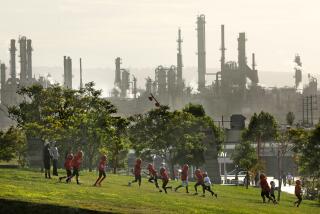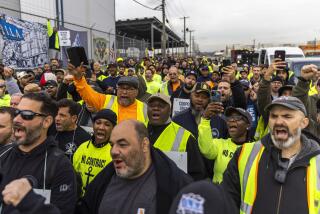Long Beach Lobbies to Save Shipyard
SAN FRANCISCO — Arguing that there is an “absolute necessity” to keep the Long Beach Naval Shipyard open, a retired vice admiral said Friday that a proposal to close it would leave the Navy dangerously short of maintenance space for very large ships.
Vice Admiral Peter M. Hekman Jr., who in the late 1980s headed the Navy’s primary administrative arm, told the Base Closure and Realignment Commission that the loss of Long Beach’s 1,200-foot-long Dry Dock No. 1 would leave the Navy with only three “carrier-capable” dry docks.
Hekman’s remarks were part of a coordinated, and at times caustic, attack on the Navy and the Department of Defense, which have targeted 33 major military installations in the latest round of base closures.
Other speakers cited the military’s allegedly “bogus” and “irrational” claims about proposed savings from closing the Long Beach shipyard.
“The supposedly analytical process,” said Rep. Steve Horn (R-Long Beach), “was one contrived to support a predetermined end.”
Officials from the Navy’s Base Structure Analysis Team, which analyzed the Navy’s facilities needs, could not be reached for comment.
Navy officials have argued that the Long Beach facility has become expendable because of dramatic reductions in the peacetime Navy, which has reduced its total number of ships from 450 to 340 in the past two years.
But the reductions have not included aircraft carriers and other large platform ships--”the very ships that require the large dry docks,” said Hekman, former head of the Naval Sea Systems Command. The Navy currently has 12 such large platform ships, with two others planned for construction.
Navy officials also have said that the Long Beach facility is less essential than others, which have the capability to service nuclear ships. But Robert S. Johnson, a former Naval Sea Systems Command civilian administrator, pointed out that the Navy has an “excess capacity” of nuclear-capable shipyards.
Five members of the eight-person commission listened without comment. Asked about Hekman’s remarks, Commissioner Rebecca G. Cox said afterward, “Obviously we’ll have to go back to the Department of Defense to see where they say they’re going to put the big ships.”
Officials of a group pressing to keep the shipyard open charged that the Navy has been biased toward San Diego, where 70% of the Pacific fleet has its home port. Private shipyards in San Diego have been lobbying to close the Long Beach facility, which they regard as a competitor.
“The only beneficiaries of the closure would be the private sector in San Diego,” said Bill Gurzi, chairman of the Southern California Save Our Shipyard Committee, “not the Navy, not the Department of Defense.”
In speaking for Gov. Pete Wilson, Lee Grissom, state director of planning and research, said the effect of three earlier rounds of base closings, along with the current round, would result in a loss of more than 215,000 jobs in the state.
“That’s the equivalent of wiping out more than half the jobs in the city of San Francisco,” Grissom said.
“California’s economy is in a precarious position,” added Sen. Barbara Boxer (D-Calif.). “Additional job losses from new base closures may be too much for us to bear.”
Long Beach Mayor Beverly O’Neill said that her city, which has already lost the Long Beach Naval Station, has taken too big a hit in the base closure process.
More to Read
Sign up for Essential California
The most important California stories and recommendations in your inbox every morning.
You may occasionally receive promotional content from the Los Angeles Times.










